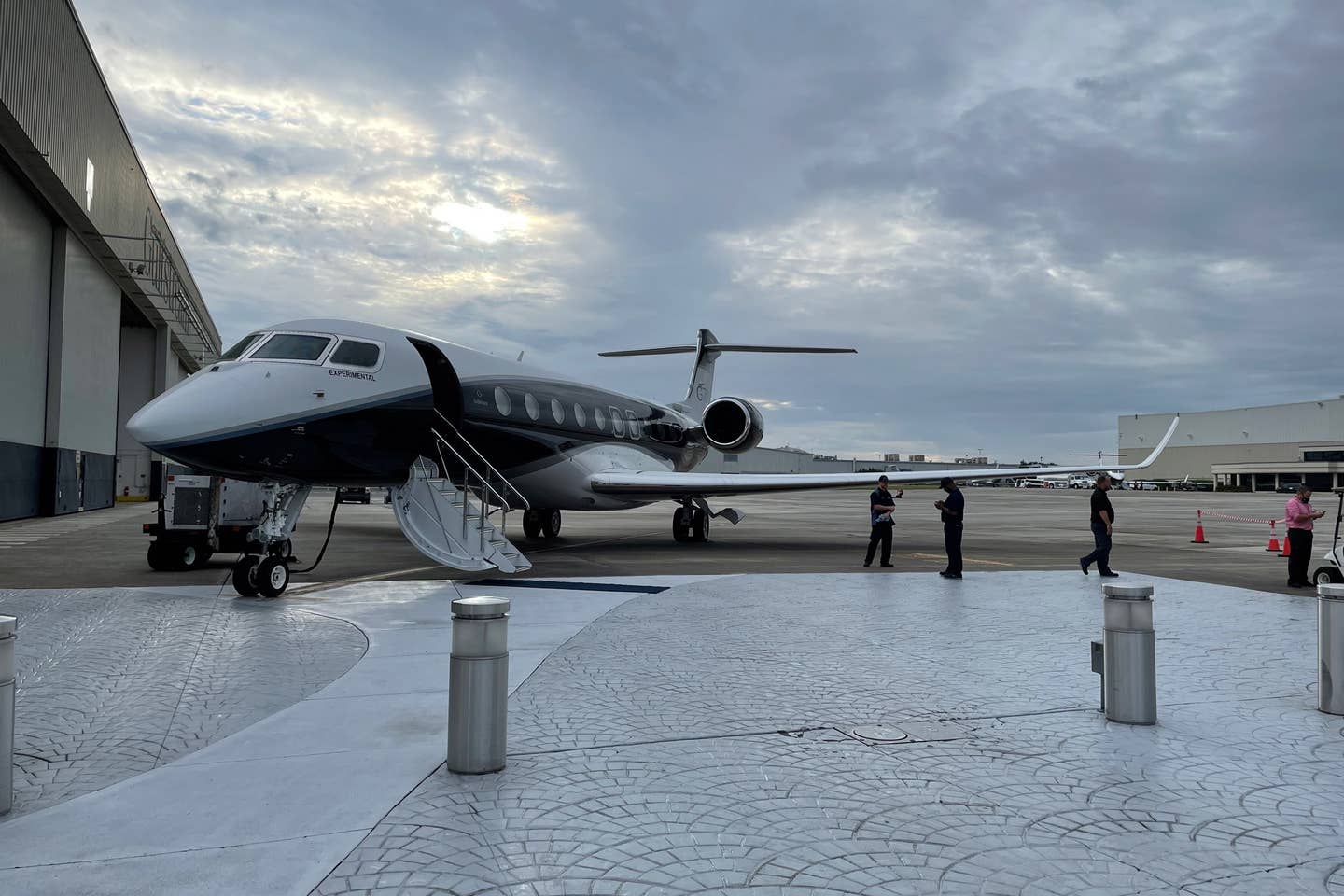
A tour of the conforming production test aircraft shows Flying how close the G700 is to certification. Julie Boatman
The first test aircraft to conform to production standards is dubbed “P1” by many aircraft manufacturers.
Gulfstream previewed its G700 P1 to Flying recently, giving us a comprehensive look at the airplane at the company’s customer center in Savannah, Georgia.
Though we didn’t get the chance to flight test the shiny new ultralong-range jet yet, we got to spend some time on the flight deck understanding what pilots can look forward to.
The company challenged the development team to create a pilot-driven airplane.
“We believe [pilots are] the best safety tools we have,” said Scott Evans, director of flight operations for Gulfstream, during our flight deck tour.
“When we started in the very beginning, our senior leadership gave Scott [Martin, master development test pilot for Gulfstream] and I basically three edicts,” he continued. “Design an aircraft [with its] flight deck by pilots for pilots, because usually they are managing the airplane and operating the airplane and they know what our customers need and how we can provide the most safety and functionality on the flight deck.
“Number two was [to] add more capability and functionality, but at the same time, make it more intuitive. That was the really hard one.
“And number three was an airplane that we could walk up to cold, and taxi away in two minutes or less. Those three basic things drove everything that we did.”
The Front Office
Evans pointed out that the flight deck serves a wide variety of roles for the pilots, calling it not only the place from which they fly the airplane and manage its system, but also “our living room, our dining room, for up to 15-plus hours.” Thus, the drive to make the area feel spacious and comfortable for those flying.
One innovative technology to enable this roominess is the integration of side sticks into the flight control system (FCS). “We’ve wanted to do side sticks at this point for about 15 years,” Evans said. The change also reduces weight, and the company expects improved reliability and easier maintenance.
“There’s no occlusion or blocking of forward displays. We can have an actual desk”—a fold-out tray table that presents the pilot with space for reviewing paperwork or having a meal.
But the company refused to incorporate side sticks until they untangled a key safety issue: the interconnection of the flight controls between the captain and first officer.
“This is an unspoken language between us when we’re flying together,” said Evans, demonstrating the paired movement of the controls in both positions.
The nonverbal communication between pilots is critical to preserve, so Gulfstream spent a decade developing active-control side sticks—as one stick is moving, the other is following along.
Intuitive Symmetry
The expansive planes of “glass” in front of the pilots is the next iteration of the Symmetry flight deck found on the G500 and G600. The common avionics suite means that Gulfstream is pursuing a common type rating across the family.
The bespoke system, developed in-house, incorporates 10 touch-screen controllers that use Gulfstream’s Phase of Flight touch actuation, as well as “side rails” that help the pilot gain purchase in turbulent air in order to accurately enter commands.
Dual head-up displays are the first in the company’s product line, and they feature its enhanced flight vision system (EFVS) and synthetic vision system (SVS) as standard equipment.
“If you add more capability and functionality, all you end up doing is driving depth of menu,” said Evans. “And it’s already pure rote learning—you’ve got to remember every key stroke to where you want to go.”
The Gulfstream team was instantly attracted to the design of the iPhones and similar devices they were starting to use personally, particularly their convertability and moldability to become whatever was needed in the moment. This concept helped guide product development on Symmetry to make it intuitive in a similar way.
The Cold Start
The third characteristic—starting cold and getting underway in the time it takes a customer to walk out of the FBO—promises to be a delighter from an operational standpoint.
Beginning with a swipe to the right on the Phase of Flight menu, the start-up checklist steps the pilot through those initial moves along with a digest of the first segment of the flight planned route. A preset configures the displays for engine start.
The start sequence is mostly automated allowing the pilot to monitor temps and percentages, though the system follows along in the background.
What’s Next?
With five test aircraft in the program—and a sixth one soon to join them—Gulfstream looks to complete certification later this year, with first customer deliveries in the fourth quarter.
Flight test has proven the G700′s performance, including the 7,500 nm range at Mach 0.85, or 6,400 nm at Mach 0.90. Takeoff distance at maximum weight is 6,250 ft, with landing at a “typical” weight and standard conditions at 2,500 ft.

Sign-up for newsletters & special offers!
Get the latest FLYING stories & special offers delivered directly to your inbox






